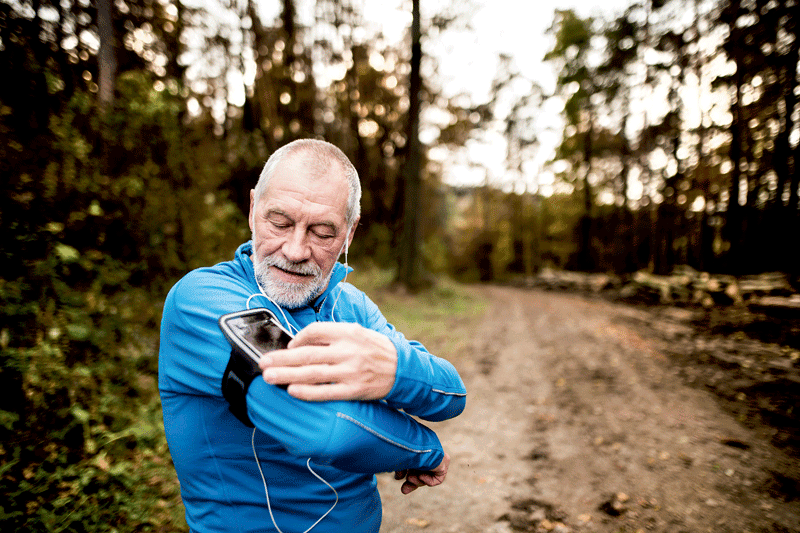Secure Connections – Technology Expands to Help Seniors Age in Place
The Baby Boom generation isn’t just marching into retirement — they’re positively surging into their senior years, with some 10,000 Americans reaching age 65 each day.
Yet, despite the fact that senior-living communities have become increasingly modernized, specialized, and resident-focused, nearly 90{06cf2b9696b159f874511d23dbc893eb1ac83014175ed30550cfff22781411e5} of seniors want to stay in their own homes as they age, according to the American Assoc. of Retired Persons.
And technology is helping them do just that — everything from home-monitoring devices to GPS trackers (for loved ones with dementia); from medication reminders to automatic stove turn-offs, and more (see story, page 16). All of it is intended to lend both security to seniors living alone and peace of mind to their loved ones.
Older Americans welcome the trend — according to the AARP survey, even if they begin to need day-to-day assistance or ongoing healthcare during retirement, 82{06cf2b9696b159f874511d23dbc893eb1ac83014175ed30550cfff22781411e5} would still prefer to stay in their own homes. Yet, the stereotype often lingers of seniors being technophobes averse to change.
“Many Boomers disagree with that statement, finding it insulting or pessimistic or both,” writes Laurie Orlov, principal analyst for Aging in Place Technology Watch, a market-research organization that provides analysis and guidance about technologies and services that enable seniors to remain longer in their home of choice. “They will repeat plaintively that Baby Boomers are very different than their parents’ generation. They are comfortable with technology. See how many have smartphones — they text, use Facebook and YouTube. Many book travel online, read TripAdvisor reviews, and even call for car pickups with an app.”
So why not embrace technology meant to improve quality of life and — just as important — independence? Especially, Orlov noted, when there are so many options, from a simple door sensor or a sophisticated whole-home automation and security system.
In the case of the former, simple technology can have profound results. “If an older adult is alone at home, enters a room, and does not return past the sensor, an alert is sent to a family member or other predefined organization, thus enabling an attempt to contact the older adult, and, if no answer, to dispatch help.”
Rachel Walker, an assistant professor in the UMass Amherst College of Nursing, has focused much of her research on addressing health disparities and the care of older adults with cancer and other serious illnesses. She’s also on the faculty for the Center for Personalized Health Monitoring (CPHM), one of three centers that make up the Institute for Applied Life Sciences at UMass Amherst, one that aims to accelerate the development and commercialization of low-cost, wearable, wireless sensor systems for personalized healthcare and biometric monitoring — but always with a focus on the human side of care.
“Oftentimes in the national news, there’s a lot of focus on the technologies — things like wearable sensors and home health monitors,” she explained. “A lot of clinicians and practitioners like myself work with individuals out in the community who experience these health challenges as they age, and there aren’t too many places that merge those two ends of the spectrum.”
Through the Wires
One reason technology isn’t an end-all, Walker said, is because, while 90{06cf2b9696b159f874511d23dbc893eb1ac83014175ed30550cfff22781411e5} of older adults prefer to stay in place, it’s a bigger challenge in the more rural areas of Western Massachusetts, where people may not have access to broadband and high-speed wireless service.
“That’s a sticky wicket. We’re embracing technology more and more, in this digital arena where people also expect to access their health record [electronically]; all these things are on the horizon, but we have whole communities in this region that have yet to get high-speed access.
“The team I work with, we would like to develop solutions that put control back in the hands of actual individuals and their caregivers,” she went on, adding that they’re using grant funds to develop a home-assessment tool that’s compatible with people’s smartphones. “Most users, even in places without high-speed wireless, have access to smartphones.”
Susan Keel, an aging-in-place specialist, recently told HGTV that a robust whole-home security system can be installed for the same cost as one month in an assisted-living facility. “With a system like this, you can remotely log in on a smartphone or the Internet, and, via the devices connected to the system, monitor your loved one’s activities.”
On a smaller scale, Orlov said personal emergency-response systems — wearable devices that can be used to alert outsiders of a health emergency or fall — is currently a $3 billion market that has evolved only slightly from its origins. But one important advance has been their use outside the home.
“The ‘I’ve fallen’ message is still inspiring families and seniors to acquire one. But 30{06cf2b9696b159f874511d23dbc893eb1ac83014175ed30550cfff22781411e5} of the market’s sales are for mobile devices. This makes sense in this time of substantial life expectancy at age 65, when 46{06cf2b9696b159f874511d23dbc893eb1ac83014175ed30550cfff22781411e5} of women aged 75+ live alone,” she notes. “Mobility demands mobile devices, which in turn boost confidence to be out and about. Consider walking the dog — since one-third of the 65+ population has one.”
The Center for Personalized Health Monitoring consolidates expertise from polymer science and engineering, computer science, kinesiology, and neuroscience as well as from other departments and collaborators, such as the UMass Medical School and industry, to develop solutions that consider the whole person, not just technology, Walker told HCN.
For example, “we’re trying to better understand what specific exercises older adults can do to improve their lower-extremity balance and strength, so they don’t have as much risk for falls,” she explained.
At the same time, however, “we’re working on home sensor networks to determine how people are using the space, so we can optimize their environment. We’ve also focused on some of the data-security problems, to make sure information is kept secure from hackers.”
In short, Walker said, there’s plenty of room for technology to help people understand their environment and manage chronic conditions and symptoms, such as fatigue and sleep impairments that, if not addressed over time, can wear the body down and lead to other types of disability. “We try to avoid that so people can stay in their homes as long as possible as they continue to age.”
Human Touch
As amazing as it is, technology doesn’t have all the answers, writes elder-care specialist Michelle Seitzer at Care.com.
“It should never be used to supplement actual caregiving — only enhance it. Certain situations may require a caregiver’s assistance or physical presence (be it a family member, neighbor, or a senior-care aide) for a few hours a week, overnight, or most of the day.
“There may also come a time when it’s just not safe for your loved one to stay home — no matter how many webcams you install,” she continues. “If a senior doesn’t answer the phone, seems withdrawn, falls frequently, misses medications, or wanders off regularly, you may need to look beyond technology. Think about options like hiring a home-care aide or finding senior housing. Figure out what works best for your loved one and the situation, and be open to changes along the way.”
Walker said her team at UMass focuses on concepts of dignity, capability, and healthcare equity in the senior years, and not on technology for its own sake.
“Any time we start a new project, we ask if there is really a need for this technology or new device. Are we building something people really need? Secondly, how will it fit into the life of the person it’s designed for? Also, who’s been left out? A lot of technology is built for the upper middle class, and that’s certainly a need, but we need to make sure what we’re building doesn’t systematically exclude certain individuals like rural residents, with no high-speed wireless access.”
Then there are unintended consequences. “Are we making someone reliant on a device, so if something breaks on the device, they’re left without a safety net to get their needs met?”
It’s an important question to keep in mind as the worlds of elder care and technology continue to cross-fertilize in new, intriguing ways.



Comments are closed.